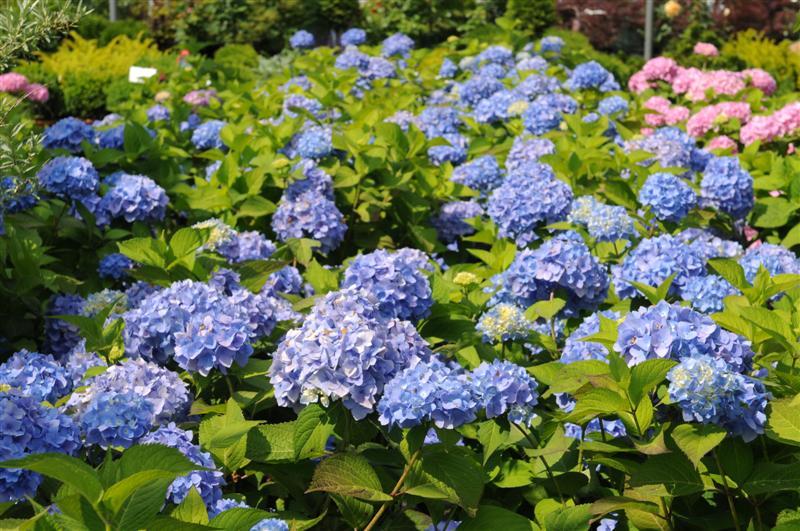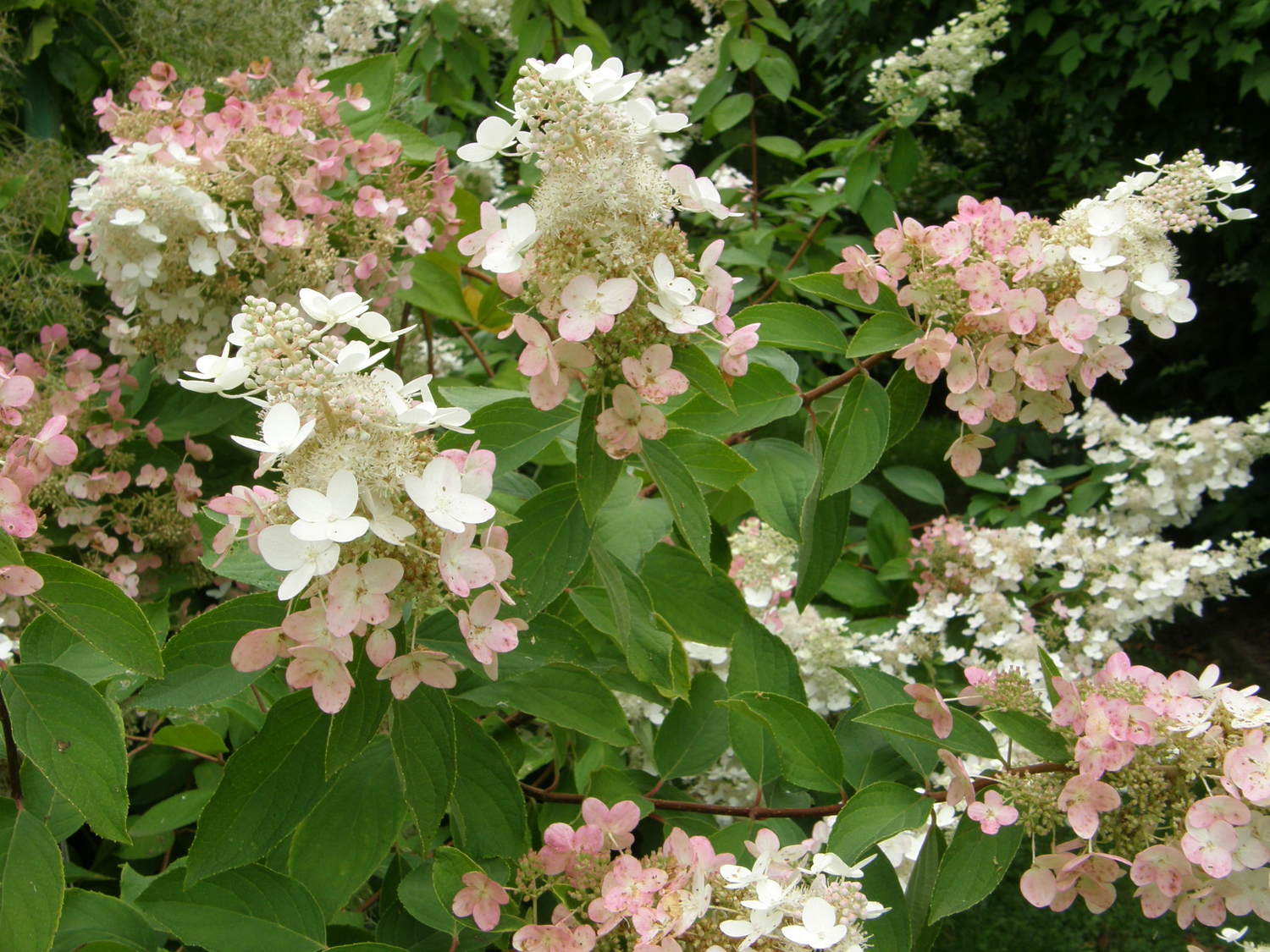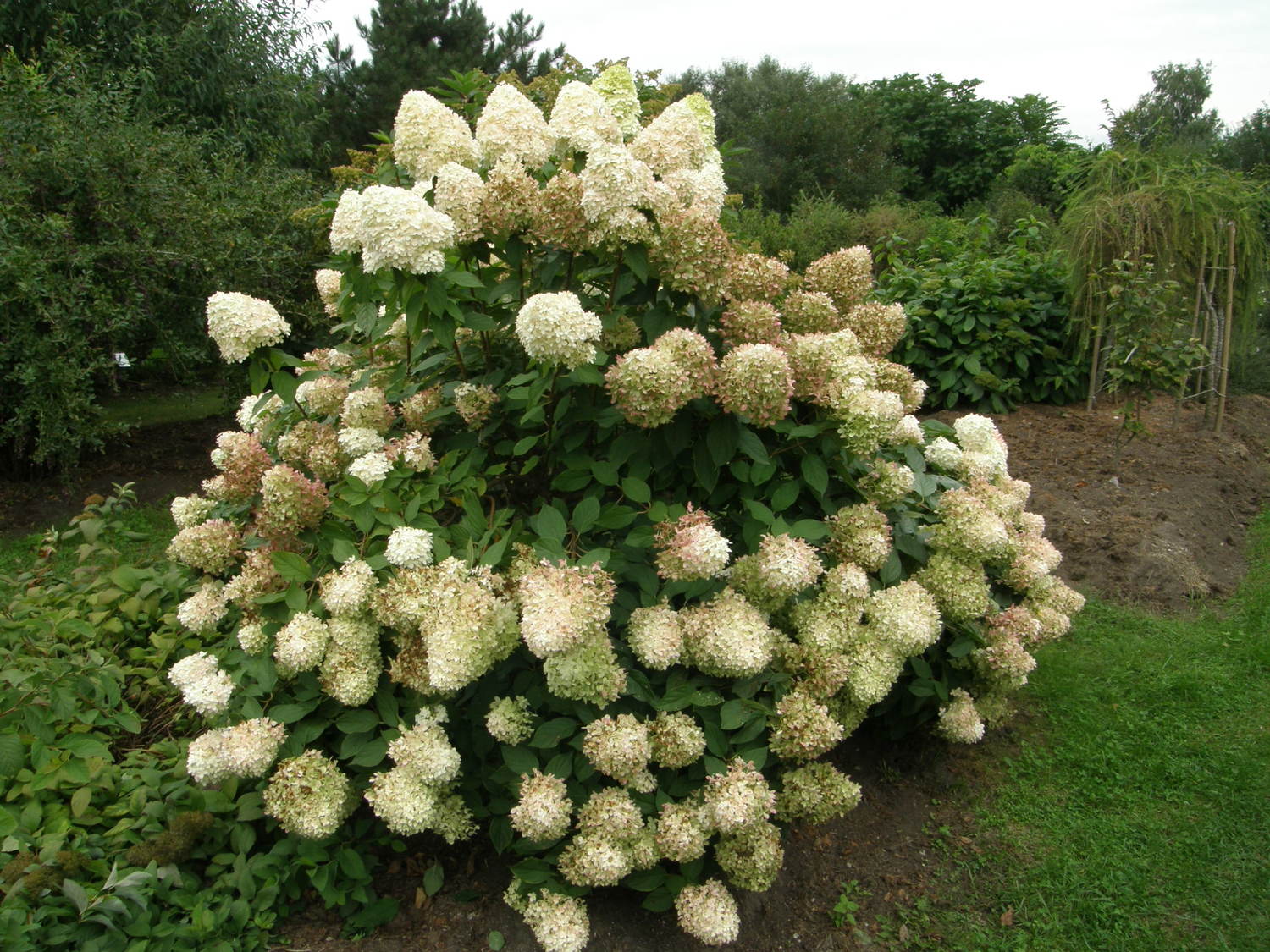When looking for plants to fill your garden with blooms, hydrangeas are one of the most wonderful and suitable choices. It might sometimes seem that this kind of plant demands quite a lot of care, however, it's not like that. It's easy to grow hydrangeas. They are also quite resistant to frost as well as to most pests and diseases. Hydrangea is a genus of over 30 different species, so you will certainly find yourself the most suitable variety.
Hydrangea plant
Hydrangea is an ornamental shrub of usually 1-3 meters in height. The plant blooms in summer or fall. Both mophead and lace cap hydrangea blooms are large and flat. Inflorescences in lace cap hydrangeas are surrounded by one or more rows of pink, white, or blue sepals. These flowers thrive best in damp soil.
The Lithuanian climate is favorable for growing hydrangeas since most species aren't sensitive to freeze and can easily survive through winter. Their colors vary from pink to blue and depend on the type, soil acidity, and pH.
Caring for hydrangeas
Having selected a suitable spot, prepared the soil for planting, and planted properly, you will increase the chance of enjoying large, colorful blooms in the coming year. If a hydrangea grows in a flowerpot, it might be transported into a warmer area in February or March so that its buds start to bloom. When the buds have blossomed, it's a must to transport the plant to a very bright place so that the hydrangea shoots don't sprout. The flowers are expected to bloom in April or May.
Planting hydrangeas
It's advised to plant hydrangeas in early spring or fall. When bought in containers, hydrangeas may be planted anytime throughout the whole warm season. First, a planting spot needs to be thoroughly prepared thoroughly. The soil of a yet-to-be-planted hydrangea must be loosened, kept clear of weeds, and mixed with decaying organic matter. Planted in loose soil, hydrangeas will grow and thrive well. They flourish in soil that is rich in organic matter. Although hydrangeas do well in damp soil, they don't tolerate being waterlogged. Soaking wet, poorly drained soil may cause root rot. Hydrangeas may then die in a matter of weeks. If you have a large amount of soil at hand, consider mixing it with a large quantity of compost to improve soil quality. Moreover, hydrangea plants need acidic soil with a pH of approximately 5.5. When soil pH is high, plants can't absorb nutrients and, most importantly, micronutrients. That is when the leaves turn yellow and the plant struggles to grow.
Before planting, dig a hole three times wider than the roots, usually of about 60-80 centimeters. However, if the soil is poor, it's better to dig a wider and deeper one of about 50-60 centimeters of depth, approximately 1.5 times as deep as the root length. Since shrubs, when planted in deep holes, sink downwards a bit, they may be planted in soil at a slightly higher level than the plant was previously planted. When the soil subsides and compacts, the proper depth will be achieved.
Fertilizing hydrangeas
Hydrangeas thrive best when fertilized in June or July with complex mineral or other well-targeted fertilizers. Mineral or organic fertilizers may be effectively used as well. It's best to fertilize with organic manure and (or) by spreading compost around the roots because it yields great results and improves soil condition. Organic soil additives might also be combined with mineral fertilizers for the utmost effect.
The quantity of mineral fertilizers used per single plant depends on the size and root system of the plant. Overfertilization may be way more harmful than under fertilization. Overfertilized hydrangea roots dry out, so the plant may be damaged or even die. It's way better to miscalculate by using an insufficient amount of fertilizer than to fertilize excessively.
Lacking experience, it is recommended to fertilize hydrangeas with store-bought complex fertilizers. More experienced florists mix the necessary quantities of fertilizers. The composition of the ingredients depends on which minerals and micronutrients the plant needs.
Phosphorus influences flower bud formation. The plant is fertilized with superphosphate in late spring with an amount of about 10-30 g/m2.
Potassium is beneficial in terms of helping the plant survive winter more easily. It also strengthens the flower budding. Fertilize with potassium sulfate or magnesia (magnesium oxide), using approximately as much of the substance as when fertilizing with superphosphate.
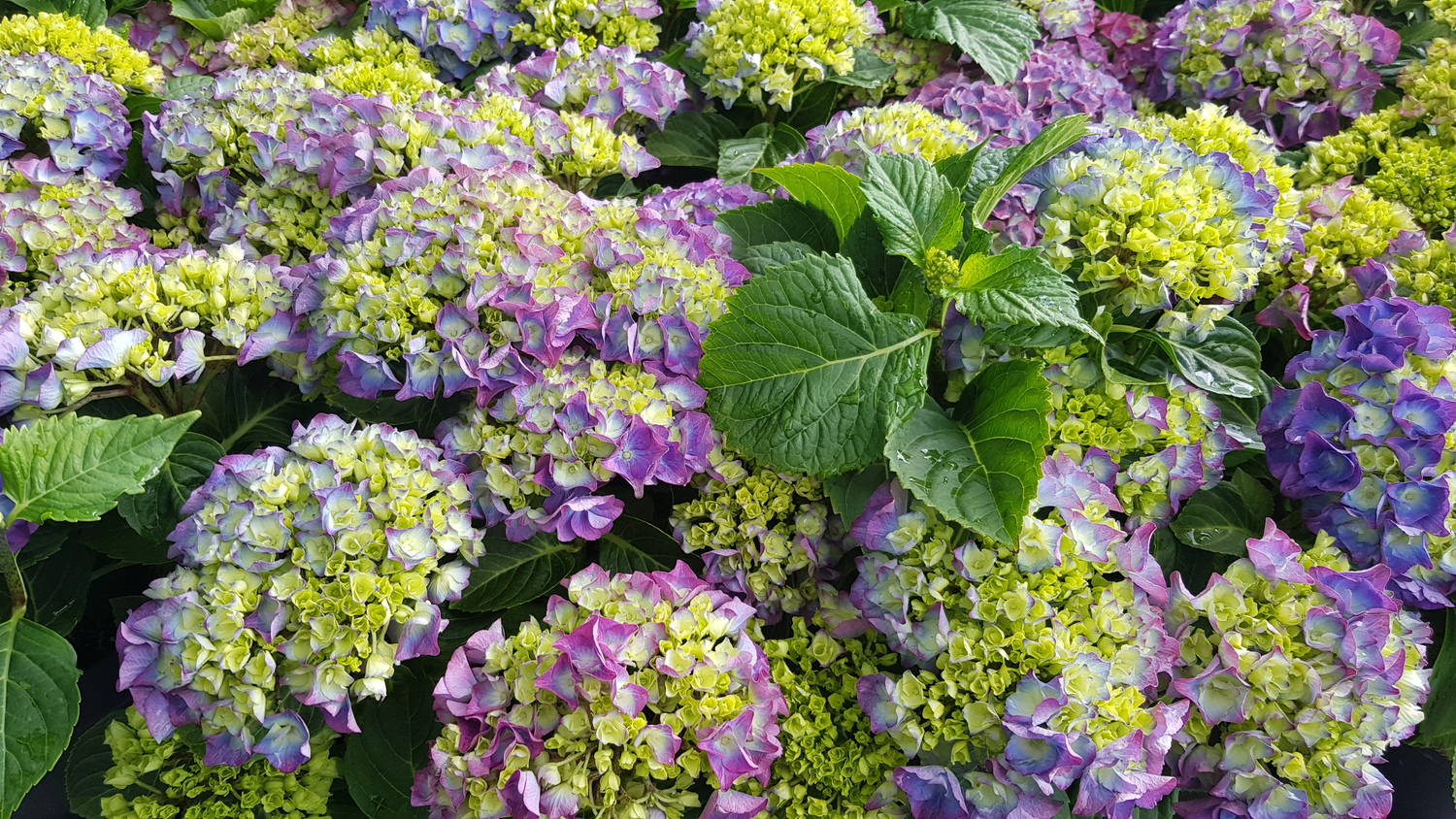
Bigleaf hydrangea (Hydrangea macrophylla)
How to prune hydrangeas?
Blooming hydrangeas are pruned so that new shoots manage to grow out of lateral buds until summer. The seasonal development cycle will then be completed. Bigleaf Hydrangea requires as little pruning as possible. Remove spent blooms above terminal buds without trimming them since bigleaf hydrangea blooms on old wood. If shoots are pruned in late fall or winter, the plant will not bloom in the coming year since the buds that had formed on new wood in fall will be trimmed as well. It happens sometimes that bigleaf hydrangea ends up being affected by a hard frost. In such a case, the plant requires a post-winter pruning; however, it will barely bloom that year. When inflorescences have finished blooming, they may be trimmed, but old wood with huge buds must be left on. Over time, such trimming will cause stems and buds to grow thinner. Therefore, it's quite necessary to implement rejuvenation pruning by occasionally cutting a few overgrown limbs so that new branches can grow in their place.
Unlike bigleaf hydrangeas, Panicle Hydrangea is heavily pruned in winter/early spring. It's best to prune after the frost, in March or April depending on the climate. All shoots from the previous year are significantly shortened. Blooms develop on new wood.
Panicle hydrangeas are pruned in two ways. First, if the hydrangea grows in poor soil, only the spent blooms are trimmed, carefully, without trimming the buds.
If hydrangea grows in healthy, wet soil and is expected to produce huge blooms, the plant is trimmed by leaving two rows of buds on old lateral stems. The stems in the middle are to be cut out. If more stems are left to grow, the branches will be weighed down by the weight of blooms. When there are too many stems growing, you may cut more stems down the branch so the plant can develop new, stronger stems. It's best to annually trim some amount of stems before winter, and some stems from the previous year.
Preferably, Smooth Hydrangea is pruned in spring, leaving a handspan to the ground uncut.
Propagation of hydrangeas
It's worth a try. Hydrangeas are propagated by vegetative propagation, with cuttings. It's best to them propagate it in the springtime, during March and April. Typically, hydrangeas produce root cuttings that are very suitable for propagation. Cuttings of 6-8 cm are cut off of a plant with a sharp knife and planted into a flowerpot or a box filled with a mixture of peat bog and sand. Before planting, the bottom leaves are removed. The cuttings are then placed on a windowsill under bright light, but they can't be exposed to direct sunlight since the cuttings may transpire too much water. The cuttings may be covered with a perforated plastic bag since less water will be transpired, air will be able to circulate as well. It's crucial for the cuttings to not wither, for they will struggle to root in. The cuttings root best under a temperature of about 20°C.
If hydrangea leaves turn yellow
Sometimes after planting hydrangea, the leaves turn yellow. It is so-called chlorosis, caused by high levels of potassium in the soil and iron deficiency. To avoid this unpleasant disease, fertilize the soil with humic acid fertilizer the moment the hydrangea is planted. The plant may also be nourished with water-soluble fertilizers filled with iron complexes, for example, fetrilon, sequestrene, optifer.
Hydrangea inflorescences: do they need to be trimmed?
Post-bloom inflorescences may be removed, but newly formed shoots must be left untrimmed as they have already developed buds for next year's flowering. Hydrangea buds form on old wood that formed the previous year.
To prevent the plant from overgrowing, shoots formed at the beginning of the summer may be trimmed. Dormant buds located in leaf axils develop new shoots that are to form next year's buds until September. If the trimmed shrub develops too many shoots, they may start growing over each other. In such a case, the shrub needs to be thinned out.
If hydrangeas fail to bloom
If the hydrangea is trimmed each year, flower buds are trimmed as well. Stems develop new shoots that don't produce blooms. For the plant to bloom, it's a must to leave elementary shoots with their already formed flower buds. These shoots can later be removed because now there will have developed new shoots capable of producing flower buds for the upcoming year. The way hydrangea grows and produces flower buds requires attentive observation.
Hydrangeas in floral design
Hydrangea blooms are very suitable for making dried flower bouquets. Blooms are picked right before the end of blooming when blooms usually turn slightly green. That's how the plant signals the end of the flowering season. Carefully picked blooms are placed in a suitable area or are directly used for bouquets or wreaths. When cut off, blossoms are very quick to dry out and slightly change color after doing so. Typically, they are picked from the end of July to mid-August.
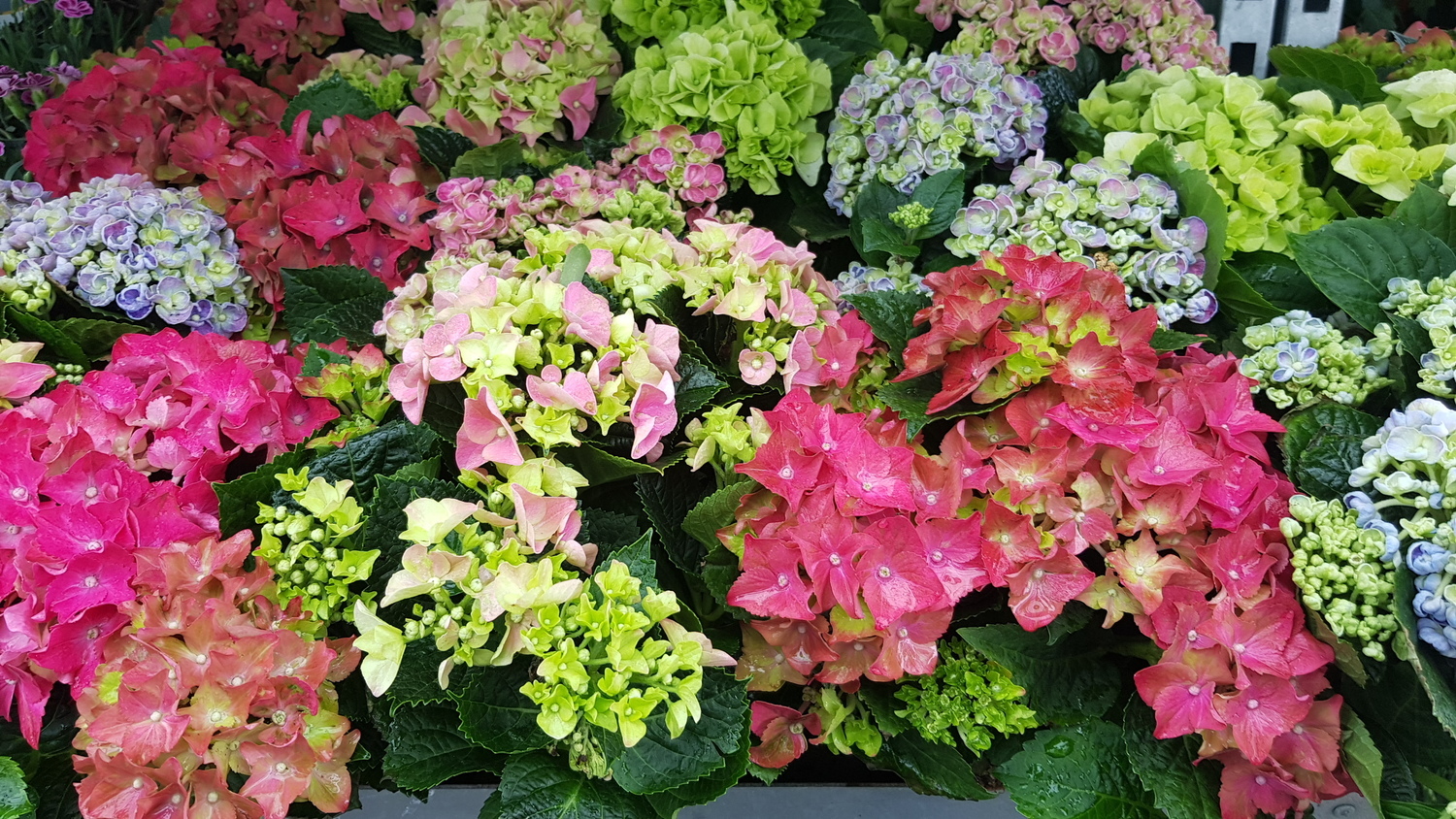
Bigleaf hydrangeas (different species)
Changing the color of hydrangeas
The color blue of hydrangea blooms depends on the color intensity of anthocyanins (pigment in plant cells).
The red anthocyanin pigment may change its color under certain conditions. This is caused by aluminum ions. During a chemical reaction, a red or pale pink pigment suddenly turns blue.
Aluminum salts dissolve in acidic soil, but in alkaline soil, they don't. That's why some hydrangea species that grow in very acidic soil bloom in blue, those that grow in less acidic soil turn red or pale pink. White hydrangeas don't change their color.
However, the soil should always contain some acid. For normal development, a pH level of 5.5-6.5 is enough. Blue hydrangeas require a pH level of 4.5-5.5.
If you aim at experimenting with colors, you may not only reduce the level of pH in soil but might also water the garden or pot hydrangeas with alum or aluminum sulfate solution (2 g per liter of water). These aluminum ions can change the color of blooms.
Hydrangea species
The most common hydrangea in Lithuania is Smooth Hydrangea (Hydrangea arborescens). Of its varieties, the most popular ones are “Grandiflora” and “Annabelle”. This type of hydrangea is most definitely known for its large creamy white blooms. When blooming for the very first time, the shrub is of light green color. But as the flower matures, it turns creamy/bright white. This type of hydrangea is easy to take care of. If grown in shade, the plant requires a medium level of soil moisture. The best sun for this species is in the morning. It may also survive direct sun, but only if the soil is constantly moist. It, in fact, can adapt to many soil conditions except drought.
Smooth hydrangea "Annabelle"
Another widespread hydrangea in Lithuania is Panicle Hydrangea (Hydrangea paniculata). It’s a reliable, fast-growing, pollution-tolerant plant, and, therefore, may grow in a city as well. This flower is also one of the most winter-hardy hydrangeas and is drought-tolerant as well. That's why this type survives the sun better compared with other species. However, they like the morning and afternoon sun best. It may be pruned at the end of winter or in spring when blooms are yet to form.
The most popular of its varieties is “Vanille Fraise” – a fascinating beauty, vertically branching deciduous shrub having ovate, sharp-edged, fairly green leaves. During the summertime, the flower develops large, white, cone-shaped flower heads that, over time, turn pink or pale pink, eventually obtaining a red tone. Grows up to 180–240 cm in height and 120–150 cm in width.
The plant is exceptionally resistant to frost and can even survive a temperature of -20°C. It's best for this plant to grow in a place accessible to both sun and partial shade. Prune the hydrangea after it's finished blooming by trimming the stems so that they continue growing freely and improve the shape of the plant.
Panicle hydrangea "Interhydia"
"Limelight" is a shrub of compact shape that grows up to 3 meters. Flower heads initially bloom in a creamy white color, later turning greenish yellow.
"Melba Fraise" resembles "Vanille Fraise" in appearance. When the flower blooms, the color of the flower heads smoothly transitions from the strawberry shade on the bottom up to the pale pink tone on the top, giving off a dramatic duotone effect. This is a flower of exceptional strength and frost resistance. Having stiff stems, the flower easily carries out copious blooming without leaning to the side. It perfectly enriches any late-season garden color palette and serves as an impressive shrub or unusual flowering hedge.
Panicle hydrangea "Limelight"
Another hydrangea species that can thrive in the Lithuanian climate is Bigleaf Hydrangea (Hydrangea macrophylla). Colors vary from pink to blue and depend on soil acidity. After the last frost, in spring, remove old inflorescences and cut the third part of all stems down to the ground surface. The plant is propagated by stem cuttings that are cut in August. Bigleaf hydrangea needs a lot of water. However, if the plant is grown in a flowerpot, it's better to be careful not to overwater it. It's quite threatening when the plant grows in a container and is watered according to the once or twice a day principle. The container may quickly become waterlogged, and the substrate begins to lack oxygen. Roots start rotting and are no longer capable of circulating a sufficient amount of water to the shoot system. Leaves wither and start falling off.
Bigleaf hydrangea "Forever Pink"
It's relatively easy to take care of bigleaf hydrangea but they don't need to be kept indoors all year long if the plant is grown in a flowerpot. Around mid-April, post-bloom hydrangeas are moved to the garden. Having found the right spot, the flower may be planted there in the garden as well. This way hydrangea may turn into a wonderful, ornamental shrub that blooms copiously each year. If a hydrangea has been growing in a flowerpot, it must be transported into a room before wintertime. Before that, shake off the excess dirt, pick off wilted, loose leaves without picking off buds. The room must be cool (4–8°C) and not too dark. The plant is watered rarely and only as much as it's needed for the roots to not completely dry out. At the end of February or in March, the hydrangea begins developing new shoots and then later forms its blooms.
Climbing hydrangea (Hydrangea petiolaris) is a creeping shrub and quite differs from other species. It clings to the supporting structures with aerial roots. The plant is perfect for a shady or north-facing wall. Fragrant, white hydrangea inflorescences bloom in July and August. The plant grows from 9 to 24 meters in height but responds well to pruning, reducing its height. Prune the hydrangea at the end of spring or at the beginning of summer to remove dead or weak branches. Remove crossing branches that might rub against each other since the rubbing opens the tree up to insects or diseases. This hydrangea may also be grown as a shrub. The plant prefers loose, fertile, and moist soil. The flower might freeze during the wintertime.

